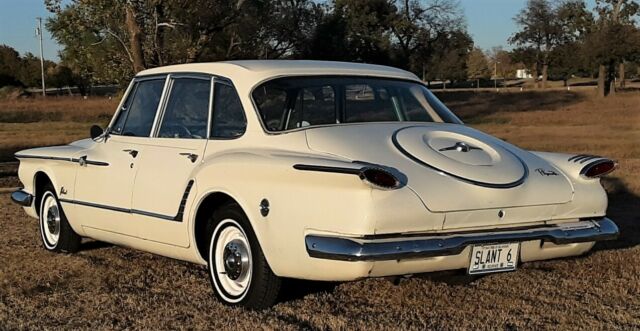1961 Plymouth Valiant V200
Technical specifications of Plymouth Valiant 1961
| Price: | - |
|---|---|
| Item location: | Miami, Oklahoma, United States |
| Make: | Plymouth |
| Model: | Valiant |
| SubModel: | V200 |
| Type: | Sedan |
| Trim: | V200 |
| Year: | 1961 |
| Mileage: | 119676 |
| VIN: | 1315134973 |
| Color: | White |
| Engine size: | 170 Slant Six |
| Number of cylinders: | 6 |
| Transmission: | Push Button TorqueFlite |
| Drive type: | RWD |
| Interior color: | Green |
| Vehicle Title: | Clean |
| You are interested? | Contact the seller! |
Description
1961 Plymouth Valiant V-200. Car is originally from California and ultimately relocated to Oklahoma. Aside from a very old repaint and seat reupholster, the car is original. Mopar glass is intact, as is trim. Trim is decent--not a lot of pitting, few dings here and there. The cloth inserts are dry and now tearing and the carpet has faded from turquoise into a light blue. Upon purchasing the car 5 years ago, I contemplated a paint job and reupholster, but ultimately opted to leave the car alone with it's rather charming patina (which seems to be popular these days) and saddle blankets over the torn seats. I also opted to replace the V-200 trim full wheel covers with the V-100 "phone dial"-style dog dish caps with correct white rims, trim rings andwhitewall tires. The rims are the original to the car--13-inch. It seems many of these cars have been upgraded to 14s due to the difficulty of finding 13-inch whitewalls. This car is the 170 slant six with a the push-button TorqueFlite automatic.The car is rust-free. The trunk floor, cab floors and wheel wells are solid. The only spot of rust on the car (oddly enough) is on the hood where the spot-welded box section of the hood hinge held water and popped though. The hood hinge does NOT flex, misalign or act compromised when the hood is opened or closed. I have lots of pictures of the underside of the car, which I can email upon request.
All gauges work. The gauge cluster hood has been replaced with a 1960 metal unit (the 1961s were some sort of plastic that always disintegrated) and there has been lots of preventative maintenance done to the car over the past few years. This car was used as a reliable occasional driver during nice weather. Maintenance includes: Routine oil changes/lube, the transmission and rear axle have been serviced, the brakes and wheel cylinders have been changed and adjusted, new tires, new shocks, the valves have been adjusted every 10,000 miles since I've owned it, fuel pump has been replaced, the car has been fully tuned up and the carburetor has been rebuilt. The waterpump has been replaced. I also just put on a new voltage regulator. The points and condenser have been replaced and gapped. The fuel tank has been professionally sealed and externally coated. I also put in a new sending unit upon the tank re-installation. The fuel filter is new. Last spring before taking the car on a road trip to Nashville, I replaced an noisy right rear axle bearing and seal. Front wheel bearings were packed during same service. Tires are 2-3 years old and probably have no more than 10,000 miles on them. I have written record of all services I have done or had done to the car.
The 1960 through 1962 Valiants have become obscure and seldom seen. It definitely gets a lot of attention when I take it out. Of note, the transmission will leak about a half-pint to a pint of fluid if it is left sitting for a length of time. I presume this is a "TorqueFlite thing" as I have heard within Mopar circles of this being common with the 904 transmission. I presume the torque converter leaks down and and somehow fills the pan to such a height that it comes out from somewhere. I have never fully explored the source as I religiously check the level and top off as needed. Sometimes it leaks after two weeks and I've had it be dry after sitting a month--so it's random. The car can be kind of cold natured, particularly when it hasn't been driven in awhile. Other than these couple eccentricities, this is a very cool, presentable and reliable first-generation Valiant. Please contact me if you have questions or would like pictures.












